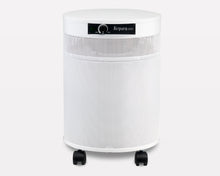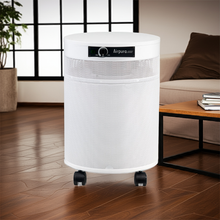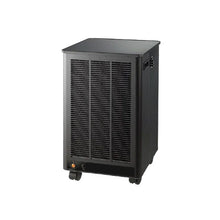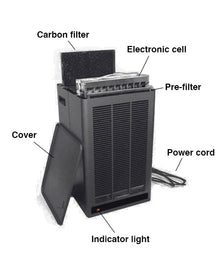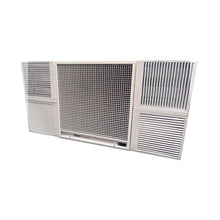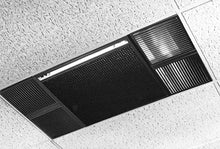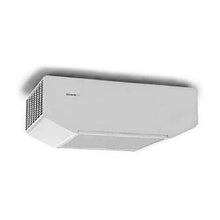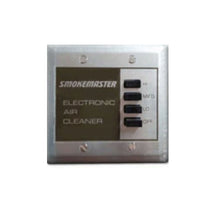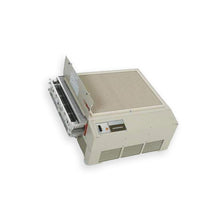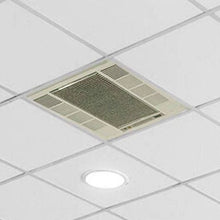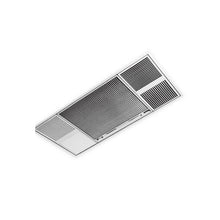Mitigating Smoke in Designated Areas

Creating comfortable and compliant spaces for smokers and vapers within or near businesses is a complex challenge. While many jurisdictions have enacted strict indoor smoking bans, the need for designated areas persists. For these areas, whether indoors or outdoors, effective ventilation and air purification are paramount. The goal isn't just to manage odors, but to genuinely protect non-smokers from exposure and ensure a pleasant experience for everyone on the premises.
At Commercial Air Purifiers, LLC, we recognize that navigating "compliance air quality smoking" regulations and designing effective "designated smoking area ventilation" can be daunting. From preventing smoke migration to adjacent non-smoking zones to dealing with the lingering effects of tobacco and vape aerosols, businesses need robust, engineered solutions. This article will delve into best practices for both "outdoor smoking area ventilation" and "indoor smoking room air filter" integration, providing insights drawn from our extensive experience in commercial air quality management. We'll explore the technologies and design principles that ensure maximum effectiveness, health, and regulatory compliance, ensuring your designated smoking areas are truly well-managed environments.
The Dual Challenge: Mitigating Smoke in Designated Areas
The fundamental challenge with designated smoking or vaping areas is containment and removal. Smoke and vape aerosols are not just visible clouds; they comprise a complex mixture of ultrafine particulate matter, volatile organic compounds (VOCs), and other harmful gases. These components readily spread, settle on surfaces (leading to thirdhand smoke), and can be transported into non-smoking areas if not properly controlled.
Why traditional approaches often fail:
-
Natural Ventilation (for outdoor areas): While open-air settings are inherently better than enclosed spaces, even "outdoor smoking area ventilation" can be insufficient. Stagnant air, wind patterns, or proximity to entrances/windows can still lead to smoke drift, impacting passersby or seeping indoors.
-
Basic Exhaust Fans (for indoor areas): A simple exhaust fan might remove some air, but without proper makeup air, pressurization control, and advanced filtration, it often falls short. Smoke can still leak through cracks, under doors, or overwhelm the fan's capacity, making an "indoor smoking room air filter" system indispensable.
-
Aesthetic vs. Functional Design: Often, smoking areas are designed for aesthetics or convenience, overlooking the critical engineering required for effective smoke control.
The health risks associated with secondhand smoke are well-documented by organizations like the Centers for Disease Control and Prevention (CDC) and the World Health Organization (WHO), emphasizing that there is no safe level of exposure. This underscores the need for proactive and highly effective "compliance air quality smoking" solutions.
Best Practices for Outdoor Smoking Area Ventilation
Even outdoors, where natural dilution is expected, strategic design can significantly improve air quality and minimize impact on surrounding areas. Effective "outdoor smoking area ventilation" aims to prevent smoke drift and reduce secondhand smoke exposure for non-smokers.
-
Strategic Location and Layout:
-
Distance from Entrances/Windows: Position smoking areas at least 25 feet (or more, depending on local regulations) away from building entrances, exits, operable windows, and ventilation intakes. This prevents smoke from being drawn into the building or impacting individuals entering/exiting. Local ordinances, such as those in Ramsey County, Minnesota, often specify these distances to prevent smoke drift.
-
Wind Patterns: Observe prevailing wind directions. Place smoking areas downwind from main building entrances and high-traffic pedestrian paths to minimize smoke being blown into unwanted areas.
-
Physical Barriers: Consider partial enclosures or tall planters to create a physical barrier that can help contain smoke, especially in more open "outdoor smoking area ventilation" designs.
-
-
Architectural Design & Material Selection:
-
Shelters and Canopies: While providing shelter from weather, ensure these are designed with ample open sides to allow for natural cross-ventilation. Avoid fully enclosed structures unless they are specifically designed as indoor smoking rooms with mechanical ventilation (see next section).
-
Non-Porous Surfaces: Use materials for floors, walls, and seating that are easy to clean and do not absorb smoke residue (e.g., metal, concrete, treated wood). This helps mitigate thirdhand smoke buildup.
-
-
Supplemental Mechanical Ventilation (When Necessary):
-
Exhaust Fans in Covered Areas: For semi-enclosed outdoor shelters or patios, strategically placed high-CFM exhaust fans can actively draw smoke upwards and away from occupants and out into the open air more effectively than passive ventilation alone. These should be positioned high to capture rising smoke.
-
Air Curtains (Limited Application): While not a primary solution for smoke, air curtains at the boundary of a semi-enclosed outdoor smoking area could, in very specific circumstances, help contain smoke within the designated zone, but their effectiveness for dense smoke is limited.
-
-
Operational Considerations:
-
Ashtrays and Waste Receptacles: Provide easily accessible and regularly emptied ashtrays and waste bins to encourage responsible disposal and prevent lingering odors from cigarette butts.
-
Regular Cleaning: Implement a rigorous cleaning schedule for all surfaces in the smoking area to minimize "clean surfaces smoke smell" from thirdhand smoke.
-
Integrating Air Purifiers into Indoor Smoking Rooms: The "Indoor Smoking Room Air Filter" Solution
For businesses where indoor smoking rooms are permitted (e.g., cigar lounges, some private clubs, designated areas in casinos or airports), mechanical ventilation and advanced air purification are absolutely essential. The goal is to create a negatively pressurized, self-contained environment where smoke is immediately removed and filtered air is not recirculated to other parts of the building. This is where an effective "indoor smoking room air filter" system becomes critical.
-
Negative Pressure Differential:
-
Concept: The smoking room must be maintained under negative pressure relative to adjacent non-smoking areas. This means that more air is exhausted from the smoking room than is supplied to it.
-
Function: This pressure differential ensures that any airflow through doorways or small cracks will always be into the smoking room, preventing smoke from leaking out into clean areas. OSHA guidelines for controlling hazardous air often refer to this principle. A common guideline is to exhaust at least 100 CFM more than is supplied.
-
Implementation: This requires a well-designed HVAC system or dedicated exhaust fans that pull air directly from the smoking room to the outside, never recirculating it into the building's main HVAC system.
-
-
High-Capacity Exhaust and Make-up Air:
-
Dedicated Exhaust System: Install robust exhaust fans (often industrial-grade) with high CFM ratings. These fans should be positioned strategically (e.g., high on walls or in the ceiling) to effectively capture rising smoke plumes.
-
100% Outdoor Air Supply: For maximum effectiveness and "compliance air quality smoking," the smoking room should ideally receive 100% fresh outdoor air as make-up air. This air should be conditioned (heated/cooled) to maintain comfort.
-
Air Changes Per Hour (ACH): Aim for very high ACH rates in indoor smoking rooms, typically 10-15+ air changes per hour, to rapidly dilute and remove smoke.
-
-
Advanced Multi-Stage Air Filtration (The "Indoor Smoking Room Air Filter"):
-
Pre-filtration/Tar Barriers: Crucial for capturing large smoke particles and sticky tar before they can clog downstream filters. These often require weekly or bi-weekly cleaning/replacement in heavy-use environments.
-
True HEPA Filtration: Essential for capturing the microscopic particulate matter (PM2.5 and ultrafine particles) from both cigarette and vape smoke/aerosols. A True HEPA filter will capture 99.97% of particles as small as 0.3 microns.
-
Massive Activated Carbon Filtration: This is the most vital component for eliminating gaseous pollutants (VOCs, nicotine, formaldehyde, etc.) and the lingering odors associated with smoke and vape. Commercial-grade "indoor smoking room air filter" units will contain 20-40+ pounds of specialized activated carbon, often impregnated for enhanced removal of smoke-specific chemicals.
-
Integration Options:
-
Dedicated Ceiling-Mounted Units: Popular in bars and lounges, these systems (often called "smoke eaters") are self-contained units that draw in smoky air, filter it, and release clean air back into the room. While they don't replace exhaust ventilation, they significantly reduce particulate and gaseous contaminants in the recirculated air within the room.
-
Ducted Air Purifiers: Large commercial air purifiers can be integrated directly into the dedicated exhaust ductwork, filtering the air before it's expelled outside, or as part of a recirculating system within the smoking room (if local regulations permit recirculation, which many don't for smoking areas).
-
Recirculating vs. Exhaust-Only: It's critical to check local regulations. Many health organizations (e.g., American Nonsmokers' Rights Foundation) and public health guidelines strongly advise against any recirculation of air from smoking rooms into non-smoking areas, even if filtered. The safest and most compliant approach for "compliance air quality smoking" is 100% exhaust to the outside with corresponding make-up air. Air purifiers in this context act as an enhancement within the smoking room, not a replacement for full exhaust.
-
-
-
Experience from Commercial Air Purifiers, LLC: We've seen firsthand that a combination of powerful dedicated exhaust, negative pressurization, and robust internal "indoor smoking room air filter" systems (with massive activated carbon) is the only way to effectively manage smoke in truly indoor settings. Without this multi-pronged approach, smoke always wins. For example, a client who owned a cigar bar implemented a system with 12 ACH of direct exhaust and several ceiling-mounted smoke eaters, each with 25 lbs of activated carbon. This dramatically improved patron and staff comfort, and the previous issue of smoke seeping into the reception area was virtually eliminated.
Compliance and Beyond: Why Best Practices Matter
"Compliance air quality smoking" extends beyond simply meeting minimum legal requirements. It's about demonstrating a commitment to health, safety, and comfort for everyone who interacts with your business.
-
Health and Safety: Adhering to best practices significantly reduces exposure to harmful secondhand and thirdhand smoke, protecting employees and non-smoking patrons. Organizations like ASHRAE (American Society of Heating, Refrigerating and Air-Conditioning Engineers) state that the only means of avoiding health effects from environmental tobacco smoke is to eliminate exposure entirely, and that ventilation and air cleaning cannot be relied upon to control ETS exposure. However, for businesses that must have smoking areas, implementing the most rigorous ventilation and filtration measures possible is the practical necessity.
-
Customer Experience: A well-ventilated smoking area ensures smokers are comfortable, while a smoke-free main area guarantees non-smokers have a pleasant experience, free from unwanted odors. This positively impacts customer satisfaction and repeat business.
-
Legal and Regulatory Adherence: Proactive implementation of best practices helps businesses stay ahead of evolving "compliance air quality smoking" regulations and avoid potential fines or legal issues. Always check local and state laws, as they can vary significantly (e.g., Minnesota's Clean Indoor Air Act, and stricter local ordinances like Ramsey County's).
Conclusion: Engineering for a Breath of Fresh Air
Designing and maintaining designated smoking areas presents a unique set of challenges for businesses. From preventing outdoor smoke drift to meticulously controlling indoor environments, effective "designated smoking area ventilation" and the integration of powerful "indoor smoking room air filter" systems are non-negotiable.
At Commercial Air Purifiers, LLC, we advocate for comprehensive, engineered solutions that prioritize health, comfort, and regulatory "compliance air quality smoking." Whether it's optimizing "outdoor smoking area ventilation" through strategic layout and supplemental fans, or implementing complex negative pressure systems with multi-stage filtration for indoor rooms, the investment in proper air quality management pays dividends in customer satisfaction, employee well-being, and long-term business success. Don't just manage smoke; actively eliminate it, creating environments where everyone can breathe easier.
Frequently Asked Questions
Q1: Is an air purifier enough for an indoor smoking room?
A1: No. An air purifier alone is not sufficient for an indoor smoking room. It must be combined with a dedicated, high-capacity exhaust ventilation system that creates negative pressure and vents all smoke directly to the outside. The air purifier (with HEPA and massive activated carbon) acts as a crucial supplement to filter recirculated air within the smoking room and capture off-gassing compounds, but it cannot replace the fundamental need for robust exhaust and proper make-up air.
Q2: What's the biggest mistake businesses make with outdoor smoking areas?
A2: The most common mistake is placing "outdoor smoking area ventilation" too close to entrances, windows, or ventilation intakes, leading to smoke seeping into the main building. Lack of strategic placement, failure to account for wind patterns, and neglecting the provision of adequate ashtrays and regular cleaning also contribute to poor management of these areas.
Q3: How do I choose the right size air purifier for my indoor smoking room?
A3: Sizing an "indoor smoking room air filter" is critical. You need to calculate the Cubic Feet per Minute (CFM) required to achieve at least 10-15 Air Changes Per Hour (ACH) for your room's volume. Then, select a commercial-grade air purifier with a CADR (Clean Air Delivery Rate) that meets or exceeds this requirement, ensuring it has substantial activated carbon for gaseous pollutant removal. It's best to consult with an air quality professional from Commercial Air Purifiers, LLC for precise sizing and system design.
Q4: Can these systems help with vape smoke as well as cigarette smoke?
A4: Yes. Advanced commercial air purifiers and ventilation systems designed for cigarette smoke are also highly effective against vape aerosols. Vape aerosols contain ultrafine particles, VOCs, and other chemicals that are captured by the HEPA and activated carbon filters within these systems. The principles of ventilation, negative pressure, and robust filtration apply equally to both types of emissions.
About the Author: Commercial Air Purifiers, LLC is a leading provider of high-quality air purification solutions for commercial, industrial, and specialized residential environments. With years of experience and a deep understanding of airborne contaminants, we are dedicated to helping businesses and individuals achieve optimal indoor air quality. Our commitment to research-backed solutions and customer well-being drives our mission to bring the best air purifiers to the market.
Publication Date: July 25, 2025
References:
-
Centers for Disease Control and Prevention (CDC). (n.d.). Secondhand Smoke (SHS) Facts. Retrieved from https://www.cdc.gov/tobacco/basic_information/secondhand_smoke/index.htm
-
American Society of Heating, Refrigerating and Air-Conditioning Engineers (ASHRAE). (n.d.). Environmental Tobacco Smoke (ETS). Retrieved from https://www.ashrae.org/about/news/2010/ashrae-position-document-on-environmental-tobacco-smoke (ASHRAE's position emphasizes elimination, but implicitly supports best practices for unavoidable exposure).
-
Ramsey County. (2022, August 26). Ramsey County Smoking and Commercial Tobacco Use Ordinance. Retrieved from https://www.ramseycounty.us/your-government/ordinances-regulations/ramsey-county-smoking-and-commercial-tobacco-use-ordinance (Local ordinance example highlighting distance requirements).
-
OSHA Technical Manual (OTM). (n.d.). Section III: Chapter 3 - Ventilation. Occupational Safety and Health Administration. Retrieved from https://www.osha.gov/otm/section-3-health-hazards/chapter-3 (General principles of ventilation, including negative pressure).
-
Innodez. (n.d.). Air Conditioning and Ventilation for Smoking Rooms. Retrieved from https://innodez.com/air-conditioning-and-ventilation-for-smoking-rooms/ (Discusses HVAC design for smoking areas).

